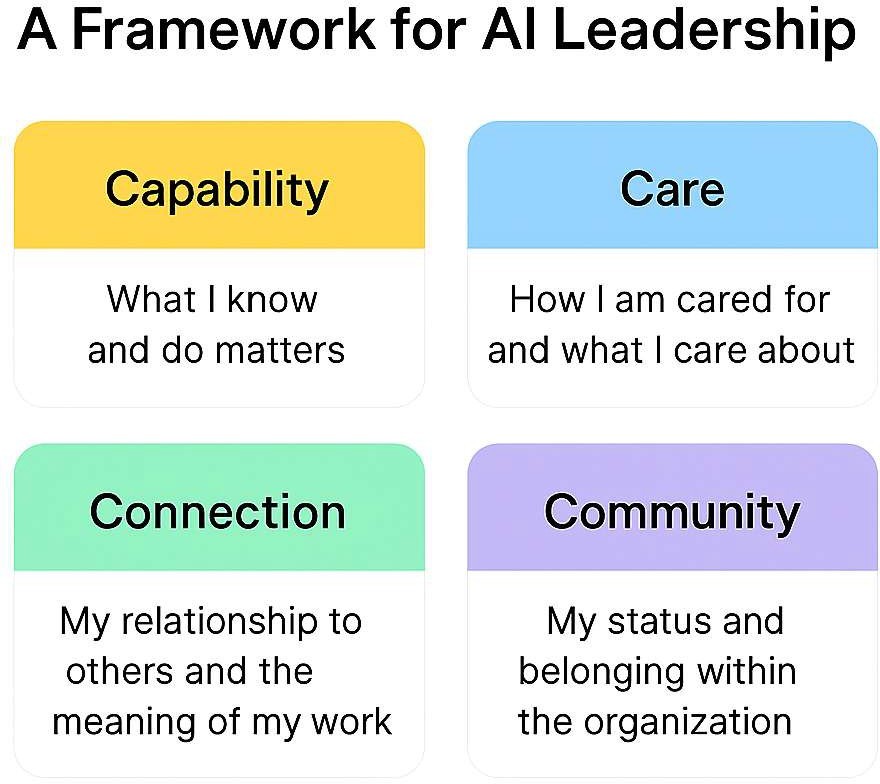Why Developing Great Leaders Matters
Think about the best boss you ever had. Perhaps it was someone like Warren, a manager who, on a sleeting Christmas Eve, surprised an employee by sending him home early with full pay. That kind of appreciation inspires people to work harder than anyone else.
Imagine an entire company filled with leaders like Warren. That’s the power of great leadership.
To develop great leaders, the focus must be on core strategies like cultivating self-awareness, committing to continuous learning, mastering communication, building strong relationships, and actively seeking opportunities to lead. Leadership isn’t just about managing tasks; it’s about influencing and inspiring people to achieve a shared purpose. It’s about cultivating more leaders, not just followers. This guide will show you how.
I’m Bill Berman. For over 30 years, as an executive coach and organizational psychologist, I’ve helped individuals and teams develop great leaders by blending management experience with deep psychological insights.

The Foundation: Understanding the Core of Great Leadership
This section establishes the essential qualities and distinctions that define effective leadership, moving beyond titles to focus on impact and influence.
The Essential Traits of an Effective Leader
When I work with clients at senior levels a common question is: “What can I do to be an excellent leader?” From my perspective as an organizational psychologist, it’s not about a title or being the loudest voice. It’s a blend of traits and skills that empower individuals to inspire and guide others.
The bedrock of leadership is profound self-awareness—a deep understanding of your personality, behaviors, and emotions. This is the foundation of emotional intelligence, the ability to perceive and manage your own emotions and those of others, which is vital for building trust and resolving conflict.
Other non-negotiable traits include integrity (honesty and transparency), a clear vision that inspires others, and masterful communication. This means speaking clearly, but more importantly, listening actively to understand meaning and intent. Finally, resilience is key. Leaders must adapt to challenges, learn from setbacks, and guide their teams through transitions with confidence.
The best leaders I’ve seen consistently communicate clearly, are passionate about their work, and prioritize organizational needs. They stay open to new ideas, support their employees, and always lead by example. For more insights on what makes someone a good leader, I often point clients to resources like Real Time Leadership. If you’re looking to cultivate these traits, personalized guidance can make all the difference. That’s why I offer Executive Coaching at Berman Leadership – to help you open up your full potential.
Leadership vs. Management: Why the Distinction Matters
“There may not be an ‘I’ in team, but there is an ‘I’ in disengaged.” This quip highlights a fundamental truth: organizational success hinges on differentiating between leadership and management. While the terms are often used interchangeably, understanding their distinct roles is crucial for cultivating effective teams.
The simplest way I explain it is this: management is about control, while leadership is about influence. A manager’s primary focus is on facilitating processes and ensuring tasks are completed efficiently. They control resources and maintain day-to-day operations.
Leadership, on the other hand, is about inspiring others toward a common purpose. It’s about influencing and motivating people, focusing on the “why” behind the work. This is the core difference between inspiring vs. directing and focusing on people vs. processes.
Here’s a table I often use to illustrate the difference:
| Focus Area |
Manager |
Leader |
| Primary Role |
Controlling a group to reach a goal |
Influencing and motivating others |
| Emphasis |
Processes, tasks, execution |
Vision, inspiration, purpose |
| Time Horizon |
Short-term, day-to-day operations |
Long-term, strategic direction |
| Impact |
Efficiency, task completion |
Engagement, growth, innovation |
| Approach |
Directing, organizing, maintaining |
Inspiring, empowering, shaping |
| Question Asked |
“How can we do this efficiently?” |
“Why are we doing this, and where are we going?” |
While these roles are distinct, they are complementary. A great leader needs management capabilities, and a great manager can display leadership qualities. As some have wisely noted, Leadership and management can work together, but they are not the same thing. The key is to understand which hat you’re wearing and when. My goal is to help individuals and organizations foster both, creating a powerful synergy that truly helps to develop great leaders.
The Path to Growth: How to Actively Develop Great Leaders
So, you’ve grasped the core of what makes a great leader. Now, how do we actually get there? Leadership isn’t something you’re simply born with; it’s a craft honed through intentional effort and continuous learning.
This next section is your roadmap. It’s about practical steps for both individuals and organizations to actively develop great leaders. Think of it as cultivating a garden: you need the right conditions to help those leadership seeds blossom.

Start with Self-Awareness to Develop Great Leaders
In my decades of coaching, I’ve learned that to develop great leaders, you must first start with yourself. The first step is cultivating profound self-awareness. It’s the cornerstone of effective leadership because it enables clearer communication, better decision-making, and more effective emotional regulation.
Self-awareness means knowing your personality, behaviors, and emotions. It’s about understanding what motivates you, what your strengths are, and where you might struggle. This is where emotional intelligence comes into play—the ability to recognize and manage your own emotions, and then to understand and positively influence the emotions of those around you.
I advise my clients to engage in consistent self-reflection. This is a deliberate practice of looking inward to understand how your actions impact others and what triggers your reactions. This process helps you process feedback and show up more authentically as a leader. Another powerful aspect of self-awareness is identifying your strengths. While acknowledging weaknesses is important, the most effective leaders lead with their strengths, leveraging their natural talents to bring authenticity to their leadership.
For anyone looking to deepen this understanding, a structured assessment can be incredibly insightful. If this resonates with you, I encourage you to Take the assessment today with Berman Leadership. And for organizations looking to nurture their rising stars, our High Potential Development at Berman Leadership programs are designed to build on these foundational insights.
Cultivate Skills Through Practice and Continuous Learning
Once you’ve started on the journey of self-awareness, the next step to develop great leaders is the relentless pursuit of skill cultivation. Leadership requires a mindset of ongoing improvement.
One of the most vital skills is active listening. This goes beyond hearing words; it means seeking to understand intent, noticing non-verbal cues, and asking thoughtful questions. Strong leaders are good communicators, but they are even better listeners. As I always say, Communication starts with active listening.
Closely related is the practice of seeking feedback. This can be uncomfortable, but it’s an indispensable catalyst for growth. Leaders who are open to constructive critique are the ones who truly evolve. Leadership development also demands deliberate practice—using every opportunity to learn and experiment with new behaviors. It’s about applying what you learn in real-world scenarios, making it stick. Finally, the role of mentorship cannot be overstated. Seeking out experienced leaders who can offer guidance and share their wisdom is invaluable.
At Berman Leadership, we often talk about the “Three E’s” framework: Environment, Equipping, and Exposure. It highlights that leadership is often more caught than taught. My team and I are passionate about helping you accept this continuous growth, and that’s why we offer programs like Lead at the Next Level with Berman Leadership to support you on this journey.
How to Develop Great Leaders by Seeking Opportunities
Cultivating leadership skills isn’t just about theory; it’s about putting yourself in situations where you must lead. To truly develop great leaders, individuals need to actively seek out opportunities to practice and hone their abilities.
One of the most effective ways to do this is through stretch assignments—tasks that push you outside your comfort zone, requiring you to learn new skills or manage complex situations. Leading projects within your current role, even small ones, provides invaluable hands-on experience in delegation, motivation, and conflict resolution. Beyond your professional responsibilities, volunteering in your community or joining professional organizations can provide rich leadership development opportunities in a different context. Finally, participating in cross-functional teams exposes you to diverse perspectives and strengthens your ability to lead complex initiatives.
The key is to proactively look for these chances. Each new experience contributes to your growth. For those ready to hit the ground running in new leadership roles, our Leadership Acceleration Onboarding at Berman Leadership is designed to help you quickly integrate and start making an impact.
Overcoming Problems: Navigating Common Leadership Challenges

In my decades of guiding leaders, I’ve seen that the journey to develop great leaders is rarely a straight line. It’s filled with challenges that demand resilience and a genuine understanding of people. Let’s explore some common problems and how to steer them.
Leading Diverse Teams is a modern reality. This diversity is a strength, but it can bring communication challenges. The strategy is to build a culture of respect and inclusion, where leaders understand what each member brings and value every viewpoint. This requires high emotional intelligence and a flexible communication style.
With diversity comes the need for Handling Conflict. Disagreements are inevitable. My approach focuses on creating psychological safety—an environment where people feel safe to speak up. When conflict arises, a leader’s role is to listen deeply and guide the conversation toward a constructive resolution. If you’re dreading those conversations, you might find this resource helpful: How to Give Feedback—Especially When You’re Dreading it.
Decision Fatigue can catch leaders off guard. Constant decision-making, often under pressure, is draining. To counter this, I encourage leaders to prioritize, delegate, and trust their teams. It’s also vital to build the courage to make difficult decisions for the greater good.
In a world of constant flux, Adapting to Change is non-negotiable. Leaders must not only accept change but also guide their teams through transitions with confidence. This requires adaptability and “learning agility”—the skill of knowing what to do even when you don’t know what to do.
Underlying all these challenges is the crucial task of Building Trust. Without trust, communication breaks down and engagement plummets. Building trust means being consistent, transparent, and showing genuine care for your team’s well-being.
Navigating these challenges calls for a custom, psychology-based approach. This is what my team of experienced coaches and I at Berman Leadership provide. You can Meet Our Coaches at Berman Leadership to learn more. We help leaders craft robust, personalized strategies to overcome any mission-critical situation.
The Organizational Imperative: Creating a Culture of Leadership
I once worked with a VP who was frustrated with her company’s leadership development. “We’re spending a fortune on programs,” she said, “but nothing’s sticking. Our people return to environments that don’t support what they’ve learned.”
Her challenge illustrates a fundamental truth: individual development withers without organizational support. To truly develop great leaders, companies must create an ecosystem that nurtures growth at every level.
This ecosystem starts with senior leadership commitment. When executives actively participate, mentor others, and visibly invest their time, it sends a powerful message. It shows that developing people is as important as developing products. Leadership development must also be aligned with business strategy. The most successful initiatives directly address the organization’s specific challenges, ensuring that the skills being developed will impact performance.
Creating psychological safety is another critical pillar. Leaders need safe spaces to experiment, fail, and learn. This means fostering environments where asking questions is encouraged and taking calculated risks is celebrated. Finally, this requires thoughtful resource allocation. Organizations need to invest in coaching and development programs, but they also need to provide time for reflection, opportunities for stretch assignments, and access to mentorship. As research highlights in guides on Developing Organizational Leaders, sustainable development requires both financial investment and structural support.
I often tell clients that the function of leadership is to produce more leaders, not just more followers. When organizations combine senior commitment, strategic alignment, psychological safety, and comprehensive resources, they create a self-sustaining culture of growth.
This comprehensive approach is exactly what we focus on in our Leadership Development Programs at Berman Leadership. We work with organizations to build these foundational elements, creating environments where leadership becomes woven into the fabric of daily work.
Frequently Asked Questions about Developing Leaders
Are great leaders born or made?
This is a timeless question. From my perspective as an organizational psychologist, the answer is a blend of both. While some individuals may have natural traits that lend themselves to leadership, the most crucial qualities are absolutely developed. Skills like navigating conflict, inspiring a diverse team, or mastering organizational dynamics are honed over time through real-world experience, continuous feedback, and intentional practice. So, while you might have a natural inclination, the journey to truly develop great leaders is a cultivated one.
How can an organization measure the effectiveness of leadership development?
Measuring the impact of leadership development is essential. It’s about looking beyond workshop attendance to tangible business results. A key area is improvements in key business metrics, such as productivity, employee engagement, and talent retention. Beyond these quantitative measures, qualitative data is equally vital. This includes using tools like 360-degree feedback assessments, which offer a comprehensive view of a leader’s performance. Regular performance reviews and qualitative surveys can track the application of new skills and behavioral changes over time, ensuring that development initiatives lead to a stronger, more positive corporate culture.
What is the single most important skill for a new leader to develop?
If I had to choose one foundational skill for a new leader, it would be self-awareness. It is the cornerstone of emotional intelligence and the starting point for all other leadership development. A leader who understands their own strengths, weaknesses, motivations, and emotional triggers is better equipped to manage their reactions, make sound decisions, and communicate effectively. Without self-awareness, feedback can feel like a personal attack rather than a growth opportunity. It is the key that open ups authentic leadership and the first step to truly develop great leaders.
Conclusion: Your Journey to Exceptional Leadership Starts Now
Think back to Warren, the manager who sent his employee home early on a sleeting Christmas Eve. That simple act of recognition created loyalty that lasted years. Imagine if every leader in your organization had that same intuitive understanding of what it means to care for their people. That’s the change we’re talking about when we develop great leaders.
Throughout this guide, we’ve explored how leadership is about inspiring rather than controlling. We’ve seen that effective leaders start with deep self-awareness, continuously hone their skills, and actively seek opportunities to grow. They steer challenges with resilience and emotional intelligence.
But leadership development isn’t a destination. It’s a continuous journey of growth, self-findy, and service to others. The shift from managing tasks to inspiring people requires courage—the vulnerability to ask for feedback and the humility to admit mistakes.
At Berman Leadership, we’ve seen this change happen countless times. When leaders accept our psychology-based approach, combining deep self-awareness with practical business skills, the results speak for themselves. Teams become more engaged, innovation flourishes, and organizations build a sustainable leadership pipeline.
Your leadership journey starts with a single step: the decision to grow. The world needs great leaders now more than ever. The question isn’t whether you have what it takes—it’s whether you’re willing to do the work to develop great leaders, starting with yourself.
Ready to take that next step? Explore Our Solutions and let’s work together to open up the leadership potential that already exists within you and your organization.







































